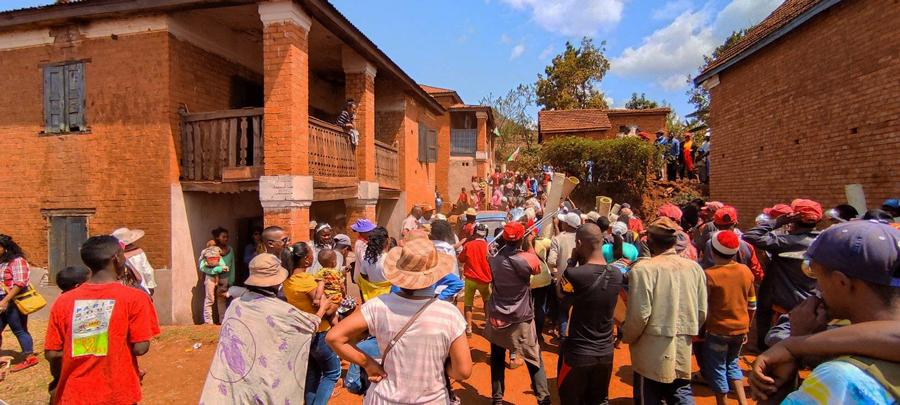A Malagasy tradition, expression and identity :
Hira Gasy is a traditional folk art form unique to Madagascar. This cultural expression, often described as musical street theater, is a captivating blend of song, dance, drama, and poetic discourse. Performances are often accompanied by colorful costumes, such as Malabary tunics for the men and dresses of the same color for the women, with the addition of the Lamba. Its roots go back many centuries, and it continues to be an integral part of Malagasy culture and identity to this day.
This form of popular entertainment is specific to the culture of the peoples of Madagascar’s central highlands, particularly the Merina, where performances take place either outdoors or indoors.
Origins and history of Vakodrazana or Hira Gasy :
Originally called Vakodrazana, the term literally means “traditions of the ancestors” (Vakoka = traditions and razana = ancestors). This art form synthesizes many artistic traditions (music, dance, oral literature) into a single performance, long upheld by the peoples of the high plateaux, specifically the Merina ethnic group.
Hira Gasy originated in rural Madagascar in the 18th century, under the reign of Andrianampoinimerina. This king, keen to propagate moral and civic values, encouraged artists to use Hira Gasy as a means of communicating and educating the masses. Hira Gasy troupes, made up mainly of peasants, accompanied the sovereign and traveled from village to village to entertain and educate the population.
The musicians’ mission was to educate the people through kabary (the art of speech) and hainteny. In this way, the king’s messages were quickly conveyed to a large audience.
For centuries, every Hira Gasy show has contained, most of the time and not without a certain humor, a lesson or moral for every category of spectator present: men, women, children, and the elderly. Love is also a recurring theme in Hira Gasy shows.
The structure and components of the show :
Generally played by an orchestra consisting in most cases of drums (amponga in Malagasy), violins, and wind instruments such as brass (trumpets and trombones) or woodwinds (clarinets, flutes or sodina), Hira Gasy is a group performance that integrates several artistic elements:
- Singing: The songs, often performed in chorus, tell stories, convey moral values, or comment on social and political events. Lyrics draw on the traditions of kabary, hain-teny, and tonon-kalo, and use ohabolana (proverbs of popular wisdom).
- Dances: Movements are synchronized and rhythmic, sometimes accompanied by acrobatics. They add a visual dimension to the performance. The women’s folk dances, featuring hand movements (“latsi-tanana”), and the men’s leg movements (“diamanga”), recall both martial arts performances and the traditional dances of Southeast Asian peoples.
- Theater: Actors perform dramatic or comic scenes, often inspired by daily life or Malagasy mythology. Today, these performances have become more entertaining, with musicians showing their creativity by improvising around subjects that captivate their audience.
- Poetic speeches: These speeches, called “kabary,” are a traditional form of eloquence used to articulate the messages of the performance.
Cultural and social significance :
Like Kabary, Hira Gasy was recently inscribed on UNESCO’s Representative List of the Intangible Cultural Heritage of Humanity in December 2023. Hira Gasy is much more than mere entertainment; it has long served as a powerful means of transmitting Malagasy values and traditions.
It also plays a crucial role in educating younger generations, imparting lessons in morality, respect, and solidarity. Today, a Hira Gasy show is held every Sunday at the royal palace of Manjakamiadana and on the sacred hill of Ambohimanga, welcoming visitors to the Rova. These performances aim to educate young people, both Malagasy and foreign, about the importance of preserving this cultural heritage.
Moreover, Hira Gasy serves as a platform for expressing social and political opinions, giving voice to rural communities and allowing them to share their concerns and aspirations with a broader audience. It serves as a forum for discussing current issues, fostering community dialogue and promoting civic engagement.
The Hira Gasy Today :
Despite social and economic changes, Hira Gasy remains a vibrant tradition in Madagascar. Rest assured, Hira Gasy practitioners, often in rural areas, are as talented as ever. Young artists, seasoned performers, and women—modern troupes continue to preserve this art form, sometimes incorporating contemporary elements to appeal to a younger and broader audience. Regular Hira Gasy festivals attest to the vitality of this tradition.
However, it is challenging to find performances in downtown Antananarivo. One must visit old royal palaces or cultural districts to attend shows, or occasionally encounter them by chance on busy streets, as Hira Gasy is also performed as street entertainment in exchange for gratuities.
Despite the challenges faced by traditional Malagasy artists, Hira Gasy has begun to garner international attention. Malagasy troupes have been invited to perform abroad, introducing a global audience to this cultural richness.






